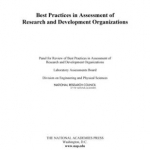Best Practices in Assessment of Research and Development Organizations
BookThis item doesn’t have any media yet
2012 | Technical
Research and development (R&D) organizations are operated by government, business, academe, and independent institutes. The success of their parent organizations is closely tied to the success of these R&D organizations. In this report, organizations refers to an organization that performs research and/or development activities (often a laboratory), and parent refers to the superordinate organization of which the R&D organization is a part. When the organization under discussion is formally labeled a laboratory, it is referred to as such. The question arises: How does one know whether an organization and its programs are achieving excellence in the best interests of its parent? Does the organization have an appropriate research staff, facilities, and equipment? Is it doing the right things at high levels of quality, relevance, and timeliness? Does it lead to successful new concepts, products, or processes that support the interests of its parent? This report offers assessment guidelines for senior management of organizations and of their parents. The report lists the major principles of assessment, noting that details will vary from one organization to another.
It provides sufficient information to inform the design of assessments, but it does not prescribe precisely how to perform them, because different techniques are needed for different types of organizations. Best Practices in Assessment of Research and Development Organizations covers three key factors that underpin the success of an R&D organization: (1) the mission of the organization and its alignment with that of the parents; (2) the relevance and impact of the organization's work; and (3) the resources provided to the organization, beginning with a high-quality staff and management.
Related Items:
| Published by | National Academies Press |
| Edition | Unknown |
| ISBN | 9780309266260 |
| Language | N/A |
Images And Data Courtesy Of: National Academies Press.
This content (including text, images, videos and other media) is published and used in accordance
with Fair Use.
